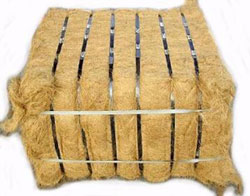 Coconut Fiber
Coconut Fiber
Coconut Husk used to be considered a waste product and the farmers just leave it in the plantation. Today, it's a source of income for them. Seeing the opportunity, Celebes put up its first coconut coir factory to extract the fiber. The coconut coir plant is equipped with tubs for soaking the coconuts and machines that separates the coconut husk from the shell, and a machine to process the husk into fiber.
Coconut husks are made of bristle fiber (10%), mattress fiber (20%) and coir dust and shorts or wastes (70%). The abundance of fiber makes it a good, stable supply for industries that make brushes, doormats, carpets, bags, ropes, yarn fishing nets, and mattresses, etc.
Coconut Peat
Coconut Peat has a high lignin (31%) and cellulose (27%) content and a carbon-nitrogen (C/N) ratio of 104: 1. It also has a very high water holding capacity of 5 to 6 times its weight. It should be noted that Coconut Peat is very stable because of the presence of high percentage of lignin. Thus, the peat left to itself takes decades to decompose. Composted peat is used along with organic supplements in crop fields in horticulture and floriculture. It is also used as a rooting and growing medium for certain ornamental flowering plants. Decomposed coconut peat is also used as hydroponics systems for growing roses and vegetables under controlled conditions. Coconut peat in sterilized condition finds use in mushroom cultivation and floriculture. It is also used as an alternative for 'Peat Moss'
Coconut Peat has a calorific value of 3975 k cal/kg, close to 4200 kcal/kg of coal. It is also used as fuel briquettes with the ash content 1/10th of coal. |